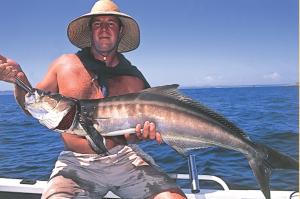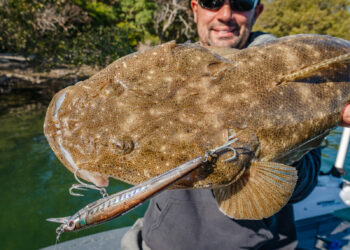Fish Facts by Dr Ben Diggles
COBIA, or black kingfish (Rachycentron canadum) are a prized target species available to fishos throughout northern Australia. This species can be found worldwide in tropical and sub-tropical waters, and in Australia they can be encountered near reefs and other structures from south-western WA, around the north of the country and as far south as the central coast of NSW.
Cobia are versatile predators which can be found inshore in estuaries and as far offshore as the continental shelf. They grow to well over 100 pounds (45 kg) in the old scale, and because of this they are a worthy sportfishing target. However, until recently very little was known about them in Australia, although they had been studied in some detail in the Gulf of Mexico. The scientific data from the US was exciting. It indicated that cobia grow very fast. The maximum age recorded for a 1.6m, 50kg+ cobia in the Gulf of Mexico was only 11 years of age. Juveniles grew to more than 60cm in their first year, and fish a metre long were only around three-years-old. Females matured in their second year when around 80 to 90cm, while male fish often matured in their first year.
In Australia, recent scientific work done by CSIRO researchers has confirmed the US results. Growth of cobia in Australia was just as rapid as it was in the US, with one-year-olds over 60cm and two-year-old fish around 80cm long. The largest cobia examined in the Australian study was 1.6m long, 55kg and only about 13-years-old. In the Gulf of Mexico, US scientists found that cobia spawned between April and September, in the northern hemisphere spring and summer. In Australia, the CSIRO found that the spawning period occurred September to June, also peaking in late spring and early summer. The size at first maturity for 50 per cent of male and female cobia in Australia was 78cm, again at about two years of age.
Female cobia produce extravagant numbers of eggs. In the Gulf of Mexico it was shown that individual cobia spawned a number of times throughout the spawning season, with gonad analysis suggesting they spawned as often as once every five to 12 days. The number of eggs spawned by female cobia varied with their size, with larger fish spawning up to 1.5 million eggs per batch. The average “batch fecundity” of cobia in Australia was even higher, around 2.8 million eggs per spawning cycle, and the spawning frequency was estimated to be around seven to eight days. That’s 10 million eggs a month, folks! CSIRO researchers also found evidence that cobia spawn mainly at night.
Because they grow so fast, cobia have high energy needs which means they aren’t generally fussy feeders, taking lures and live baits readily. Dietary studies indicate they feed mostly near the bottom and that cobia prefer to eat crustaceans, particularly crabs, when they are available. Fortunately for those who’d rather eat their blue swimmer
crabs than use them for bait, when crabs aren’t on the menu, stomach content analysis
has shown that cobia will eat virtually any type of fish that is locally available, including stingrays and flatfish.
Even though they grow so fast and are highly fecund, CSIRO researchers warned that natural and fishing mortality rates of cobia were quite high, and that the current minimum length of 75cm in Queensland may still result in growth overfishing. This led them to suggest that a minimum size of 85cm might be more appropriate, still slightly less than the 92cm minimum size in places like Mississippi in the Gulf of Mexico. Waiting for a cobia to grow from 75 to 85cm would represent 3-4 months at the rate this species grows, which, one would think, is cheap insurance to improve protection of these great sportfish for years to come.





















